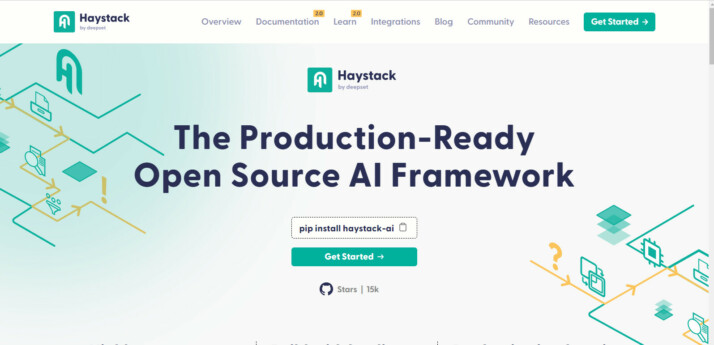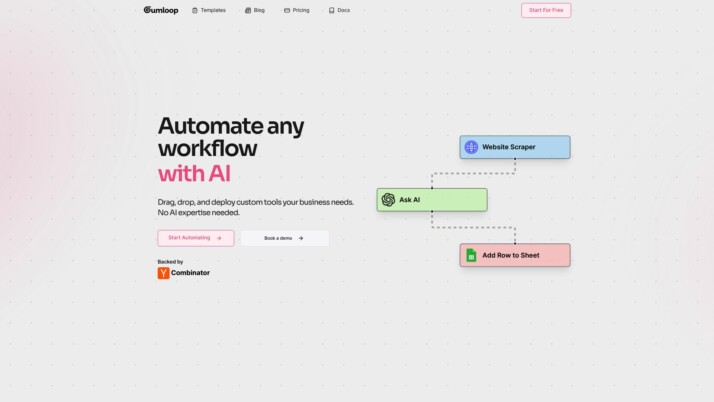Haystack vs. AgentHub: AI Development Platforms Compared
AI-powered software development tools have transformed the landscape of application creation, offering unprecedented capabilities to developers and businesses alike. In this comparison, we explore three leading platforms: Haystack vs. AgentHub, and SmythOS. Each offers unique approaches to harnessing AI for building powerful applications, from natural language processing to workflow automation. We’ll delve into their core features, ease of use, and target audiences to help you determine which platform best suits your development needs. Whether you’re a seasoned developer seeking advanced AI integration or a business professional looking for no-code solutions, this guide will illuminate the strengths and potential limitations of each platform, empowering you to make an informed decision in your AI development journey.
Haystack Overview
Haystack empowers developers to build production-ready applications using Large Language Models (LLMs) and vector search. This open-source framework excels in tasks like retrieval-augmented generation, document search, and question answering. Haystack’s modular components allow developers to create custom search experiences and conversational chatbots by integrating tools like Hugging Face Transformers, Elasticsearch, and OpenAI into flexible pipelines.


Haystack empowers developers to build production-ready applications using Large Language Models (LLMs) and vector search.
Haystack shines in natural language processing (NLP) applications, offering robust support for complex queries and tasks. The framework orchestrates LLMs and retrieval methods to handle intricate problem-solving scenarios. Developers can leverage Haystack’s AI agents, which use various tools to resolve queries step-by-step, inspired by advanced AI concepts like MRKL and ReAct.
The platform’s strength lies in its versatility and scalability. Haystack supports multimodal retrieval of texts, tables, and other content types, making it suitable for diverse use cases. For teams, Haystack facilitates collaborative development with tools for team-based NLP application creation. The framework also handles large-scale document processing and indexing, crucial for enterprises dealing with vast amounts of data.
Haystack supports multimodal retrieval of texts, tables, and other content types, making it suitable for diverse use cases.
While Haystack offers powerful capabilities, it may present a steeper learning curve for non-technical users. The platform lacks a visual builder or no-code editor, requiring users to interact with the system through code. This approach provides flexibility for experienced developers but might be challenging for those seeking a more guided, visual experience in building AI applications.
Haystack integrates seamlessly with popular AI models and tools, including BERT variants and models hosted on Hugging Face. It supports deployment as APIs and webhooks, enabling easy integration into existing systems. However, the framework doesn’t offer specific features for staging domains or scheduled agent deployment, which might limit certain deployment scenarios.
AgentHub Overview
AgentHub revolutionizes AI automation with its no-code platform, empowering businesses to create sophisticated AI-powered workflows without coding expertise. The drag-and-drop visual builder simplifies the process of designing and deploying custom AI agents for a variety of applications.


AgentHub revolutionizes AI automation with its no-code platform, empowering businesses to create sophisticated AI-powered workflows without coding expertise.
At its core, AgentHub offers a suite of tools tailored for lead generation, client management, and marketing automation. Real estate professionals benefit from streamlined processes for tracking client communications, managing transactions, and automating marketing campaigns. The platform’s reporting and analytics capabilities enable data-driven decision-making, while collaboration tools foster teamwork among agents and external partners.
AgentHub’s standout features include its collection of pre-optimized agents, designed to tackle specific tasks without requiring users to select prompts or tools. This approach significantly reduces the learning curve for new users while still offering the flexibility to customize workflows through a variety of nodes. The platform’s integration capabilities ensure seamless connection with multiple external systems, enhancing its applicability across different business environments.
AgentHub’s standout features include its collection of pre-optimized agents, designed to tackle specific tasks without requiring users to select prompts or tools.
While AgentHub excels in user-friendliness and pre-built solutions, it may have limitations in areas such as advanced customization or specialized AI model integration. The platform’s focus on accessibility and ease of use potentially comes at the expense of some of the more complex features that experienced developers might require for highly specialized applications.
AgentHub positions itself as a democratizing force in AI automation, aiming to make these powerful tools accessible to businesses regardless of their technical expertise. This vision aligns with the growing trend of no-code platforms in the tech industry, potentially opening up new possibilities for businesses to leverage AI without significant investment in technical resources or training.
Feature Comparison
SmythOS and Haystack offer distinct approaches to AI agent development, with notable differences in their core components and security features. SmythOS provides a visual builder and no-code editor, enabling users to create AI workflows without programming expertise. This contrasts with Haystack’s code-centric approach, which may present a steeper learning curve for non-technical users.
In terms of security, SmythOS implements constrained alignment to ensure AI behavior aligns with organizational goals and ethical guidelines. Haystack lacks this specific feature, potentially limiting control over AI agent actions in sensitive environments. Both platforms offer data encryption, but SmythOS extends its security measures with IP control capabilities, providing an additional layer of access management not present in Haystack.
SmythOS’s comprehensive hosting options, including staging and production domains, surpass Haystack’s offerings. While both support API and webhook deployments, SmythOS’s additional deployment options as scheduled agents and site chat broaden its applicability across various use cases. These differences highlight SmythOS’s focus on accessibility and versatility, making it a more adaptable solution for diverse AI development needs.
Feature Comparison Table
| Haystack | AgentHub | SmythOS | |
|---|---|---|---|
| CORE FEATURES | |||
| Visual Builder | ❌ | ✅ | ✅ |
| No-Code Options | ❌ | ✅ | ✅ |
| Multimodal | ✅ | ❌ | ✅ |
| Agent Work Scheduler | ❌ | ✅ | ✅ |
| SECURITY | |||
| Constrained Alignment | ❌ | ❌ | ✅ |
| Data Encryption | ✅ | ❌ | ✅ |
| OAuth | ✅ | ❌ | ✅ |
| IP Control | ❌ | ❌ | ✅ |
| COMPONENTS | |||
| Huggingface AIs | ✅ | ❌ | ✅ |
| Zapier APIs | ❌ | ❌ | ✅ |
| Classifiers | ✅ | ❌ | ✅ |
| Data Lakes | ❌ | ❌ | ✅ |
| DEPLOYMENT OPTIONS (EMBODIMENTS) | |||
| Staging Domains | ❌ | ❌ | ✅ |
| Production Domains | ❌ | ❌ | ✅ |
| API Authentication (OAuth + Key) | ✅ | ❌ | ✅ |
| Deploy as Site Chat | ✅ | ❌ | ✅ |
| Deploy as Scheduled Agent | ❌ | ✅ | ✅ |
| Deploy as GPT | ✅ | ❌ | ✅ |
| DATA LAKE SUPPORT | |||
| Hosted Vector Database | ✅ | ❌ | ✅ |
| Sitemap Crawler | ❌ | ❌ | ✅ |
| YouTube Transcript Crawler | ❌ | ❌ | ✅ |
| PDF Support | ✅ | ❌ | ✅ |
| Word File Support | ✅ | ❌ | ✅ |
| TXT File Support | ✅ | ❌ | ✅ |
Best Alternative to Haystack and AgentHub
SmythOS emerges as the superior alternative to Haystack and AgentHub, offering a comprehensive platform for AI agent development and deployment. Our intuitive drag-and-drop interface empowers users to create sophisticated AI workflows without extensive coding knowledge, making advanced AI functionalities accessible to a broader audience.
Unlike Haystack’s code-centric approach or AgentHub’s limited feature set, SmythOS provides a versatile ecosystem that supports a wide range of AI models and integrations. We offer seamless connectivity with popular services like Slack, Trello, and GitHub, as well as support for custom API integrations. This flexibility ensures that SmythOS can adapt to virtually any workflow or business process.
SmythOS stands out with its robust security features, including constrained alignment and IP control… These capabilities ensure that AI agents operate within defined parameters, addressing critical concerns about AI safety and ethical use.
SmythOS stands out with its robust security features, including constrained alignment and IP control, which are absent in both Haystack and AgentHub. These capabilities ensure that AI agents operate within defined parameters, addressing critical concerns about AI safety and ethical use. Additionally, our platform supports multimodal interactions, allowing AI agents to process and respond to various data types, including text, images, and voice.
Our platform’s scalability and deployment options surpass those of Haystack and AgentHub. SmythOS enables users to deploy AI agents across multiple environments, including as APIs, chatbots, scheduled tasks, and even as GPT models. This versatility, combined with our hosted vector database and support for various data formats, positions SmythOS as the ideal choice for businesses seeking a comprehensive AI solution that can grow with their needs.
By choosing SmythOS, users gain access to a powerful, user-friendly platform that accelerates AI development and deployment. Our commitment to innovation and user empowerment makes SmythOS the clear leader in the AI agent builder space, offering unparalleled capabilities that drive efficiency and innovation across industries.
Conclusion
Haystack, AgentHub, and SmythOS each offer unique approaches to AI-powered application development, but SmythOS stands out as the superior choice for businesses seeking a comprehensive, user-friendly AI solution.
Haystack provides a powerful open-source framework for developers comfortable with code-based solutions. Its strengths in natural language processing and retrieval-augmented generation make it suitable for complex NLP tasks. AgentHub offers an accessible no-code platform, ideal for businesses looking to automate workflows without extensive technical expertise.
SmythOS, however, combines the best of both worlds. Our platform’s visual builder and no-code editor rival AgentHub’s ease of use, while our extensive AI capabilities match or exceed Haystack’s offerings. SmythOS’s unparalleled integration ecosystem, with over 300,000 available connections, empowers users to create sophisticated AI workflows effortlessly.
Unlike its competitors, SmythOS provides enterprise-grade features such as constrained alignment, ensuring AI behavior aligns with organizational goals, and comprehensive deployment options including APIs, webhooks, and scheduled agents. Our “Create Once, Deploy Anywhere” philosophy enables seamless integration across multiple platforms, from chatbots to custom APIs.
For businesses ready to harness the full potential of AI, create a free SmythOS account today. Experience the power of unlimited AI agents, a 30-day money-back guarantee, and the ability to deploy AI agents anywhere. Explore our diverse range of AI-powered agent templates to jumpstart your AI journey and revolutionize your workflow with intelligent automation.
Last updated:
Disclaimer: The information presented in this article is for general informational purposes only and is provided as is. While we strive to keep the content up-to-date and accurate, we make no representations or warranties of any kind, express or implied, about the completeness, accuracy, reliability, suitability, or availability of the information contained in this article.
Any reliance you place on such information is strictly at your own risk. We reserve the right to make additions, deletions, or modifications to the contents of this article at any time without prior notice.
In no event will we be liable for any loss or damage including without limitation, indirect or consequential loss or damage, or any loss or damage whatsoever arising from loss of data, profits, or any other loss not specified herein arising out of, or in connection with, the use of this article.
Despite our best efforts, this article may contain oversights, errors, or omissions. If you notice any inaccuracies or have concerns about the content, please report them through our content feedback form. Your input helps us maintain the quality and reliability of our information.
